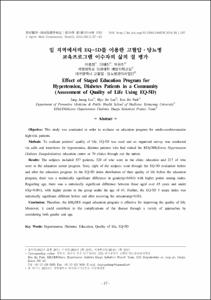KUMEL Repository
1. Journal Papers (연구논문)
1. School of Medicine (의과대학)
Dept. of Preventive Medicine (예방의학)
일 지역에서의 EQ-5D를 이용한 고혈압·당뇨병 교육프로그램 이수자의 삶의 질 평가
- Keimyung Author(s)
- Lee, Jung Jeung
- Department
- Dept. of Preventive Medicine (예방의학)
- Journal Title
- 농촌의학·지역보건
- Issued Date
- 2014
- Volume
- 39
- Issue
- 1
- Abstract
- Objective: This study was conducted in order to evaluate an education program for cardio-cerebrovascular
high-risk patients.
Methods: To evaluate patients’ quality of life, EQ-5D was used and an organized survey was conducted
via calls and interviews for hypertension, diabetes patients who had visited the KHyDDI(Korea Hypertension
Diabetes DaeguInitiative) education center or 70 clinics through out the nation.
Results: The subjects included 537 patients, 320 of who were in the clinic education and 217 of who
were in the education center program. Sixty eight of the subjects went through the EQ-5D evaluation before
and after the education program. In the EQ-5D index distribution of their quality of life before the education
program, there was a statistically significant difference in gender(p<0.001) with higher points among males.
Regarding age, there was a statistically significant difference between those aged over 65 years and under
65(p<0.001), with higher points in the group under the age of 65. Further, the EQ-5D 5 scope index was
statistically significant different before and after receiving the education(p<0.05).
Conclusion: Therefore, the KHyDDI staged education program is effective for improving the quality of life.
Moreover, it could contribute to the complications of the disease through a variety of approaches by
considering both gender and age.
Key Words: Hypertension, Diabetes, Education, Quality of life, EQ-5D
본 연구에서는 EQ-5D를 이용한 삶의 질 측정을 통해 심뇌혈관질환 고위험군에게 적용될 수 있는 교육프로그램의 효과를 평가하고자 하였다. 2012년 3월부터 12월까지 교육정보센터의 단계별 교육프로그램 이수한 490명 중 교육 전, 후 EQ-5D 평가를 모두 실시한 68명을 대상으로 삶의 질을 비교하였다. 교육 전 대상자들의 삶의 질 지표는 성별, 연령, 대구시 등록관리사업에 등록한 등록군에 따라 높게 나타났고 통계적으로 유의한 차이를 나타내었다(P<0.05). 교육 전, 후 대상자들의 EQ-5D 지표가 통계적으로 유의한 차이를 보인 변수는 남성(P<0.05), 여성(p<0.001), 65세 미만군(p<0.001), 65세 이상군(p<0.01), 고혈압군(p<0.001), 당뇨병군(p<0.01), 등록군(p<0.05), 미등록군(p<0.001)이었다. 교육이수 후 EQ-5D 5개 하위 차원별 문제 호소 응답 비율은 '다소' 혹은 '심각한' 문제가 있다고 대답한 비율이 '통증/불편감' 36.8%, '불안/우울' 26.5%, '운동능력' 22.1%, '일상활동' 7.4%의 순이었고, 교육 전, 후의 EQ-5D 5개 하위 차원별 문제 호소 응답 비율에 유의적인 차이가 있었다(p<0.05). '운동능력'의 경우 당뇨병군을 제외한 모든 군에서 '일상활동'의 경우 고혈압군, 당뇨병군, 정상군, 미등록군을 제외한 모든 군에서 교육 전보다 교육이수 후 EQ-5D 하위 차원별 문제 호소율이 유의적으로 감소하였고(p<0.05), '통증/불편감'의 경우 당뇨병군을 제외한 모든 군에서 '불안/우울'은 남성, 당뇨병군을 제외한 모든 군에서 EQ-5D 하위 차원별 문제 호소율이 유의적으로 감소하였다(p<0.05). 따라서, 교육정보센터의 단계별 교육프로그램등 센터와 병의원에 시행하는 교육은 삶의 질 향상에 효과적인 교육으로 평가할 수 있으며 추후 성별, 연령을 고려한 다양한 접근 방법과 프로그램을 통해 합병증 예방에도 기여할 수 있을 것으로 기대한다.
- Alternative Title
- Effect of Staged Education Program for Hypertension, Diabetes Patients in a Community (Assessment of Quality of Life Using EQ-5D)
- Keimyung Author(s)(Kor)
- 이중정
- Publisher
- School of Medicine
- Citation
- 이중정 et al. (2014). 일 지역에서의 EQ-5D를 이용한 고혈압·당뇨병 교육프로그램 이수자의 삶의 질 평가. 농촌의학·지역보건, 39(1), 37–45. doi: 10.5393/JAMCH.2014.39.1.037
- Type
- Article
- ISSN
- 1738-9577
- Appears in Collections:
- 1. School of Medicine (의과대학) > Dept. of Preventive Medicine (예방의학)
- 파일 목록
-
-
Download
 oak-bbb-00257.pdf
기타 데이터 / 717.54 kB / Adobe PDF
oak-bbb-00257.pdf
기타 데이터 / 717.54 kB / Adobe PDF
-
Items in Repository are protected by copyright, with all rights reserved, unless otherwise indicated.